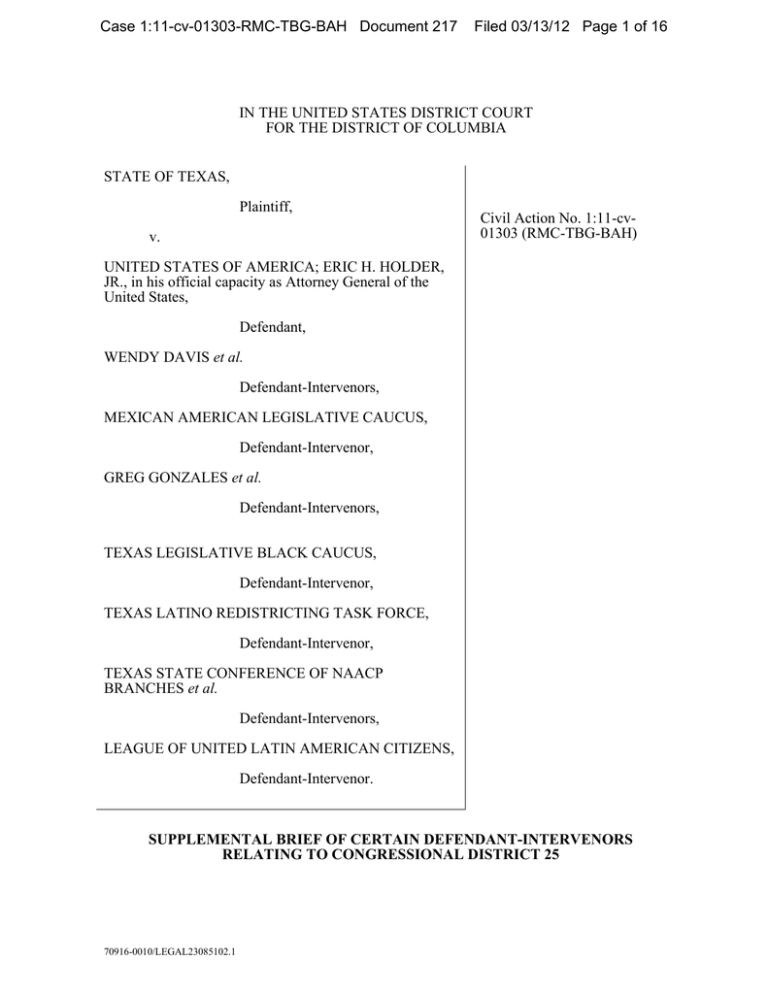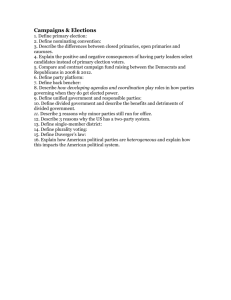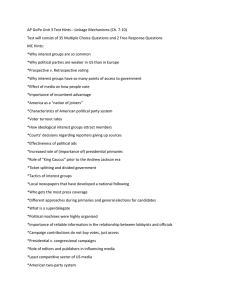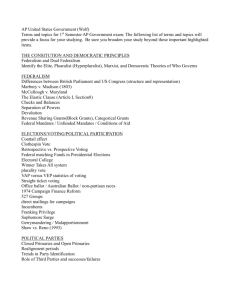IN THE UNITED STATES DISTRICT COURT FOR THE DISTRICT OF COLUMBIA Plaintiff,
advertisement

Case 1:11-cv-01303-RMC-TBG-BAH Document 217 Filed 03/13/12 Page 1 of 16 IN THE UNITED STATES DISTRICT COURT FOR THE DISTRICT OF COLUMBIA STATE OF TEXAS, Plaintiff, v. Civil Action No. 1:11-cv01303 (RMC-TBG-BAH) UNITED STATES OF AMERICA; ERIC H. HOLDER, JR., in his official capacity as Attorney General of the United States, Defendant, WENDY DAVIS et al. Defendant-Intervenors, MEXICAN AMERICAN LEGISLATIVE CAUCUS, Defendant-Intervenor, GREG GONZALES et al. Defendant-Intervenors, TEXAS LEGISLATIVE BLACK CAUCUS, Defendant-Intervenor, TEXAS LATINO REDISTRICTING TASK FORCE, Defendant-Intervenor, TEXAS STATE CONFERENCE OF NAACP BRANCHES et al. Defendant-Intervenors, LEAGUE OF UNITED LATIN AMERICAN CITIZENS, Defendant-Intervenor. SUPPLEMENTAL BRIEF OF CERTAIN DEFENDANT-INTERVENORS RELATING TO CONGRESSIONAL DISTRICT 25 70916-0010/LEGAL23085102.1 Case 1:11-cv-01303-RMC-TBG-BAH Document 217 I. Filed 03/13/12 Page 2 of 16 Introduction and Summary Defendant-Intervenors, the League of United Latin American Citizens (LULAC), the Texas Legislative Black Caucus, the Texas State Conference of NAACP Branches, the Gonzales Intervenors, and the Davis Intervenors, submit this brief in response to the Court's Minute Order issued March 6, 2012. The Minute Order directs the Texas Latino Redistricting Task Force (Task Force) to describe its "reasoning for and the evidence behind its conclusion that 'Anglo voters dominate the Democratic primary in CD 25.'" In the discussion that follows, DefendantIntervenors demonstrate that the evidence the Task Force provided in support of its Advisory filed February 24, 2012, actually supports the opposite conclusion – namely, that Whites do not dominate primary elections in CD 25 and that the candidates supported by Blacks and Hispanics consistently receive a majority of the vote in the primaries. The primary election results the Task Force itself provided with its Advisory show that minority-preferred candidates received a majority of the total vote in five of six primaries in 2008 and 2010. With these results established by its own data, the Task Force's claim of "White domination" in CD 25 primaries is beyond puzzling. The Task Force's claim is all the more perplexing when one considers the primary election results that the Task Force failed to provide. Although the ultimate issue with respect to CD 25 is whether minorities have the ability to elect candidates of their choice in congressional elections, the Task Force ignores the performance of the minority-preferred candidate in CD 25, Congressman Lloyd Doggett, in congressional primaries. But in the 2004 Democratic primary in CD 25, Blacks and Hispanics overwhelmingly preferred Congressman Doggett, and he soundly defeated his Latino primary opponent. While Congressman Doggett was unopposed in subsequent primaries in CD 25, Blacks and Hispanics still turned out and voted for him in significant numbers. 70916-0010/LEGAL23085102.1 -2- Case 1:11-cv-01303-RMC-TBG-BAH Document 217 Filed 03/13/12 Page 3 of 16 The Task Force's omission of the congressional primaries stems from an even broader flaw in its analysis of whether minorities are able to elect the candidates of their choice in primaries in CD 25. The incomplete sample of primaries the Task Force provided with its Advisory includes only primaries in which a candidate with a Spanish surname ran for office. The Task Force assumes that a non-Hispanic candidate – a Black or a White candidate, for example – could never be the minority-preferred candidate in CD 25. But the electoral success of Congressman Doggett, who is White, with minority voters in CD 25 shows the fallacy of that assumption. The Task Force's false premise causes it to ignore primary results in CD 25 that prove minority-preferred candidates consistently receive a majority of the total vote in the district. Far more comprehensive and reliable than the Task Force's sweeping statements about primaries in CD 25 is the exhaustive analysis of dozens of primaries in CD 25 and Travis County that Dr. Stephen Ansolabehere provided. His analysis, which neither the Task Force nor Texas rebutted, establishes that no racial group dominates the primary process in CD 25 and Travis County. Power is shared equally and in such a way that each of the racial groups – Hispanics, Blacks, and Whites – succeeds in nominating their preferred candidates 75 percent of the time. Of 43 primaries in Travis County analyzed by Dr. Ansolabehere, Whites backed the winner in 31 primaries; Hispanics backed the winner in 32 primaries; and Blacks backed the winner in 31 primaries. There is overlap among the groups in the candidates that they most prefer. In the rare cases in which the winner of the primary was preferred by just one group and opposed by the other two (six instances), the Hispanic preferred candidate won most often (three times); the Black preferred candidate won twice; and the white preferred candidate won just once. These results demonstrate that minoritypreferred candidates have the ability to win the Democratic primaries in CD 25 Travis County, and that the Task Force's claim of "White domination" in the primaries is specious. 70916-0010/LEGAL23085102.1 -3- Case 1:11-cv-01303-RMC-TBG-BAH Document 217 Filed 03/13/12 Page 4 of 16 Finally, the Task Force ignores the results of general elections in CD 25 and Travis County, even though, as the Gonzales Intervenors have previously demonstrated, courts routinely rely on general elections to identify minority-ability districts. For example, in Lewis v. Alamanace Cnty., N.C., 99 F.3d 600, 614–16 (4th Cir. 1996), cert. denied, 520 U.S. 1229 (1997), the Fourth Circuit court flatly rejected "the proposition that success of a minority-preferred candidate in a general election is entitled to less weight when a candidate with far greater minority support was defeated in the primary.” Id. at 615 (internal quotation marks omitted). As the court aptly explained, “[s]uch a view is grounded in the belief that minority voters essentially take their marbles and go home whenever the candidate whom they prefer most in the primary does not prevail, a belief about minority voters that we do not share.” Id. Here, it is undisputed that Blacks and Hispanics have the ability to elect candidates of their choice in general elections in CD 25, as Texas's expert, Dr. John Alford, has admitted. Thus, even if there were any merit – which there isn't – to the Task Force's claim that minorities in CD 25 are unable to elect their preferred candidates in primaries, CD 25 would still qualify as a minority-ability district because of the success of minorities in general elections. A. II. Argument The Task Force's Election Data Establish that Minority-Preferred Candidates Consistently Receive a Majority of the Total Vote in Primaries in CD 25 One has to wonder whether the Task Force took the time to review the election data it provided to the Court before stating that Whites "dominate" the primaries in CD 25 and prevent minorities from electing candidates of their choice. As described, those data directly contradict the Task Force's claim, establishing that the minority-preferred candidates won the majority of the vote in CD 25 in five of six primaries in 2008 and 2010. The following summary describes those results. The primary results the Task Force provided for 2010 elections in CD 25 included Democratic primaries for the offices of lieutenant governor and land commissioner. See 70916-0010/LEGAL23085102.1 -4- Case 1:11-cv-01303-RMC-TBG-BAH Document 217 Filed 03/13/12 Page 5 of 16 Task Force Advisory Ex. DX0441. As established by the Task Force's expert, Dr. Richard Engstrom, the minority-preferred candidate in the lieutenant governor primary was Ronnie Earle.1 The primary results provided by the Task Force show that Earle won an overwhelming majority of the total vote – 62% – in CD 25 in the primary, meaning that the minority-preferred candidate was chosen by the voters in CD 25. Task Force Advisory Ex. DX0441. Similarly, in the Democratic primary for land commissioner, the minoritypreferred candidate – as established by the Task Force's expert, Dr. Engstrom – was Hector Uribe, and he received 57% of the total vote in CD 25. Id.2 Thus, in both 2010 primaries, the Task Force relies upon for its claim of White domination, the minority-preferred candidates won a majority of the vote in CD 25. In most of the cases presented as evidence of White dominance, the Hispanicpreferred candidate won. While the Republican primaries are less probative of whether CD 25 is minority-performing than the Democratic primaries, the Task Force cites one 2010 Republican primary – for the position of railroad commissioner – as support for its claim of White domination in the CD 25 primaries. The candidate preferred by all groups in that primary, including Blacks and Hispanics, was David Porter.3 The primary results provided by the Task Force show that Porter received 62% of the total vote in CD 25 – another overwhelming victory in a primary for the minority-preferred candidate. Task Force Advisory Ex. DX0441. Also in 2010, in another primary the Task Force omitted, Governor Perry was the minority-preferred candidate in the Republican gubernatorial primary in CD 25. He defeated Debra Medina with a solid majority of the total vote in CD 25, which 1 See multivariate analysis for Lieutenant Governor Democratic Primary 2010 in Engstrom, Rebuttal Report, September 2, 2011 at 59. 2 See Defendants' Ex. 724 (Ansolabehere Rebuttal Rpt. to Supp. Rpt. of Alford) at Attachment 5 (Showing the percentages of White, Hispanic and Black voters who supported candidates with Spanish surnames based on Dr. Engstrom's analysis). 3 See multivariate analysis for Lieutenant Governor Democratic Primary 2010 in Engstrom, Rebuttal Report, September 2, 2011 at 60. 70916-0010/LEGAL23085102.1 -5- Case 1:11-cv-01303-RMC-TBG-BAH Document 217 Filed 03/13/12 Page 6 of 16 included strong support from minorities.4 Accordingly, just as with the Democratic primaries, a majority of voters in CD 25 supported the minority-preferred candidates in the Republican primaries. For 2008, the Task Force provided results from three Democratic primaries for the offices of U.S. Senator, "Texas Supreme Court 7, and "Texas Supreme Court 8." See Task Force Advisory Ex. DX0440. The minority-preferred candidates in the Senate and Supreme Court 8 primaries were, respectively, Rick Noriega and Linda Yanez. See Defendants' Ex. 724 (Ansolabehere Rebuttal Rpt. to Supp. Rpt. of Alford) at Attachment 5. In CD 25, Noriega won 58% of the total vote in the primary, and Yanez won 54% of the total vote. Task Force Advisory Ex. DX0440. Again, in both primaries, the minority-preferred candidates received a solid majority of the vote in CD 25. In only one of three primaries – the primary for Supreme Court 7 – the minority-preferred candidate did not win a majority of the vote in CD 25 (Baltasar Cruz was the minority-preferred candidate, and he received 45% of the total vote). Defendants' Ex. 724 (Ansolabehere Rebuttal Rpt. to Supp. Rpt. of Alford) at Attachment 5. In sum, minority-preferred candidates won substantial majorities of the total vote in CD 25 in five of the six primaries reflected in the Task Force's exhibits. Including the 2010 gubernatorial election increases the number to six of seven primary elections. B. The Task Force Uses Erroneous Assumptions and Incomplete Data in Evaluating Primary Elections In addition to relying on primary results that contradict its claim of White domination in primaries in CD 25, the Task Force makes erroneous assumptions concerning which primaries are relevant. It excludes dozens of primaries in CD 25 and Travis County, which contributes to the inaccurate conclusion it reaches about the ability of minorities to elect the candidates of their choice. As described, the Task Force's apparent starting premise is that 4 Id. 70916-0010/LEGAL23085102.1 -6- Case 1:11-cv-01303-RMC-TBG-BAH Document 217 Filed 03/13/12 Page 7 of 16 only candidates who have Spanish surnames can be minority-preferred. Thus, the exhibits the Task Force provided with its Advisory include results only for primaries involving a candidate with a Spanish surname. See Task Force Advisory Exs. DX0437, DX0439, DX0440, DX0441. Under the Task Force's simplistic approach, it is assumed that minorities were not able to elect the candidate of their choice if the candidate with the Spanish surname did not receive a majority of the vote in CD 25. The obvious flaw in this approach is that the minority-preferred candidates are often non-Hispanics (e.g., Congressman Doggett), and minorities do not always support candidates with Spanish surnames (e.g., Congressman Canseco in CD 23). Because the Task Force excludes primaries that involve only non-Hispanic candidates, its analysis of primaries is incomplete. The relevant question is whether minorities have the ability to elect their preferred candidates, not whether they have the ability to elect candidates with Spanish surnames. The Task Force's most glaring omission of this type is its failure to include the congressional primaries in CD 25 involving Congressman Doggett. There is agreement among the experts in this case – including Texas's expert, Dr. Alford – that Congressman Doggett is the minority-preferred candidate in CD 25. Yet, the Task Force did not include primaries involving Congressman Doggett in its analysis, presumably because he is a nonHispanic. As result, the Task Force ignores the 2004 Democratic primary in which Congressman Doggett prevailed against a Latino opponent – Leticia Hinojsa – in CD 25 with strong support from Black and Hispanic voters. See Defendants' Ex. 724 (Ansolabehere Rebuttal Rpt. to Supp. Rpt. of Alford) at 23 & n.3.5 The fact that a White candidate, Congressman Doggett, defeated a Latino opponent with the help of significant support from 5 The boundaries of CD 25 were modified after 2004, and the results of the 2004 primary election in that district therefore do not provide a precise comparison for performance under the Benchmark plan. However, both the 2004 version of CD 25 and the Benchmark version included most of the same portions of Travis County, including the core of the County's tri-ethnic coalition. Accordingly, the results from the Democratic primary in 2004 are still relevant in determining the minority-ability status of CD 25 under the Benchmark plan. 70916-0010/LEGAL23085102.1 -7- Case 1:11-cv-01303-RMC-TBG-BAH Document 217 Filed 03/13/12 Page 8 of 16 Hispanic voters directly refutes the Task Force's premise that Hispanics prefer only candidates with Spanish surnames. In addition to excluding that primary, the Task Force omits the 2006, 2008, and 2010 primaries in which Congressman Doggett, while running unopposed, again received overwhelming support from Black and Hispanic voters. Id. at 2024. Moreover, the Task Force completely disregards the dozens of primaries in Travis Count in which the minority-preferred candidates have been elected. Id. at 22-24 & Attachment 6. These elections bear directly on the ability of minorities in CD 25 to elect candidates of their choice in primaries, since Travis County comprises about 60% of the area that CD 25 encompasses. As Dr. Ansolabehere described, Blacks and Hispanics succeeded in electing their preferred candidates in dozens of Travis County primaries held in recent years. Id. While excluding these plainly relevant primaries, the Task Force includes in its analysis other election data that fail to shed any light on whether minorities currently have the ability to elect preferred candidates in Benchmark CD 25. For example, the Task Force exhibits include results from four primaries in 2002 involving the office of governor and three different judicial offices. Task Force Advisory Ex. DX0437. But the Task Force does not identify which candidates in those primaries were minority-preferred, and none of the experts in this case evaluated elections that far back in time. As a result, it isn't possible to draw any conclusions about the performance of minority-preferred candidates in those primaries. In addition, given the significant changes in the racial make-up of Texas over the last decade, results from primaries in 2002 are hardly a reliable indicator of whether CD 25 has more recently been a minority-ability district.6 6 The Task Force's approach of using incomplete data also is shown by its reliance on a 2006 Democratic "runoff" election for lieutenant governor. The Task Force fails to include the results from the Democratic primary that preceded the run-off. 70916-0010/LEGAL23085102.1 -8- Case 1:11-cv-01303-RMC-TBG-BAH Document 217 C. Filed 03/13/12 Page 9 of 16 Minority-Preferred Candidates Win Approximately 75% of Primary Elections in CD 25 As Dr. Ansolabehere has described, minority-preferred candidates win approximately 75% of the primaries in CD 25 and Travis County. Defendants' Ex. 724 (Ansolabehere Rebuttal Rpt. to Supp. Rpt. of Alford) at 23-24. Not surprisingly, this percentage is consistent with the success rate of the minority-preferred candidates in the six Democratic primaries in 2008 and 2010 for which the Task Force provided results. Unlike the Task Force's incomplete analysis, however, Dr. Ansolabehere's conclusion is based on dozens of elections in CD 25 and Travis County. These results point out another significant flaw underlying the Task Force's claim of White domination in the primaries in CD 25. According to the Task Force, Whites supposedly dominate the primaries because Hispanics and Blacks are only 34% of the citizen voting population in the district, while Whites are 61% of the CVAP. Advisory at 3. But this assertion ignores that more than half of the voters comprising the White CVAP in CD 25 are Republicans who do not participate in the Democratic primaries. As explained below in Section D, when the White CVAP is reduced to account for Republicans, the total minority CVAP for Democratic primaries is greater than the White CVAP. It is thus not at all surprising that minorities are able to elect their preferred candidates in 75% of the primaries in CD 25. Thus, the Task Force's assertion that CD 25 is a majority White district that mostly elects White candidates is demonstrably wrong. In Democratic primaries, Whites are not the majority, and minority candidates consistently receive a majority of the vote in those elections. Indeed, the Task Force's own exhibits show minority candidates – Noriega, Uribe, and Yanez, for example – winning a majority of the vote in nearly all the CD 25 primaries that the Task Force reported. 70916-0010/LEGAL23085102.1 -9- Case 1:11-cv-01303-RMC-TBG-BAH Document 217 D. Filed 03/13/12 Page 10 of 16 Whites do not Dominate the Primary Electorate in CD 25 Based on representations the Task Force made to the Texas court in the most recent remedial hearing in that court, the Defendant-Intervenors expect the Task Force to assert here that CVAP data show that Whites are the majority of the primary electorate in CD 25. But CVAP data do not reflect turnout in either the general elections or the primary elections. In fact, the CVAP surely understates the presence of Hispanics and Blacks in the Democratic primary electorate. Because minorities overwhelmingly vote Democratic, they are more likely to vote in the Democratic primary and to be a much larger share of the Democratic primary electorate than the overall electorate. A simple calculation suggests that the Benchmark CD 25 is not dominated by Whites. According to ecological regression estimates provided by Dr. Engstrom, Dr. Kousser, and Dr. Ansolabehere, almost all Blacks and the vast majority of Hispanics vote for Democratic candidates in the general elections in CD 25 under Plan C100, while roughly 45% of Whites in this area choose Democratic candidates.7 Applying those proportions to the CVAP figures facilitates apportioning the potential electorate into the Democratic primary electorate. This would lead one to assign all of the Blacks, 90% of the Hispanics, and 45% of the Whites in CD 25 under Plan C100 to the Democratic primary. This calculation shows that no group is a majority of the primary electorate: Hispanics and Blacks combined are estimated to be a majority of the primary electorate (with 38% and 15% respectively); Whites are estimated to be less than half of the Democratic primary electorate (47%). This simple calculation is consistent with the fact that no single group’s preferred candidate wins more often than any other group’s preferred candidate in the Democratic primary, as shown in Dr. Ansolabehere’s supplemental expert report. Defendants' Ex. 724 (Ansolabehere Rebuttal Rpt. to Supp. Rpt. of Alford) at 23-24. 7 See, e.g., Defendants' Ex. 728 (Engstrom Rebuttal Report) at 56-57. 70916-0010/LEGAL23085102.1 -10- Case 1:11-cv-01303-RMC-TBG-BAH Document 217 Filed 03/13/12 Page 11 of 16 It is also notable that no evidence is provided showing that Hispanics would be a majority of the Democratic primary electorate in the proposed CD 35. The only evidence offered is the Hispanic percent of Citizen Voting Age Population. Those data are not turnout data, and no calculations are offered showing that Whites are not – or would not be – the majority of the Democratic primary electorate in proposed CD 35. Finally, in the recent remedial hearing before the Texas court, the Task Force made oblique references to an analysis of primary election turnout conducted by the Texas Attorney General. The thrust of the Task Force's references was that minority turnout in CD 25 is too low to influence the outcomes of elections – a claim that is inaccurate and unsupported by any evidence in this record. Anticipating that the Task Force may make the same claim in its upcoming submission relating to CD 25, the Defendant-Intervenors emphasize that this analysis has not been made available for evaluation by DefendantIntervenor's experts. However, Texas's expert, Professor Alford, has reviewed the methodology and turnout figures and has concluded they are patently unreliable, as he explained in testimony to this Court: I told you this was not the analysis that goes into reconstituted elections. It is not my racially polarized voting analysis. I saw this analysis from the State when I was first hired in this process over a year ago. I – if you will take a quick look at the last two columns, I think you will agree with me that there is very little reason to put any faith in this particular analysis. I don’t put any faith in this analysis. I have not relied on the analysis. Precisely what you are about to talk about here, because of a variety of technical things, we don’t need to discuss. I mean, look at the general election in 2004. This model estimated that the turnout was 26 percent. The actual turnout in the election was 40.8 percent. The error in this model is enormous, and it is increased when we try to estimate the increase in the categories. I don’t rely on this. I’m happy to go through this hypothetical with you, but I don’t – I just don’t wan the Court to think that this is actually a reliable indication of turnout in the district. (Trial Tr., January 24 Afternoon session, at 86-87) 70916-0010/LEGAL23085102.1 -11- Case 1:11-cv-01303-RMC-TBG-BAH Document 217 Filed 03/13/12 Page 12 of 16 Relatedly, Defendant-Intervenors anticipate that the Task Force may cite Table 3 in Exhibit DX0441 – attached to the Task Force's Advisory – as proof of turnout by racial groups in primary elections in CD 25. That table contains information on voter registration, SSVR, and overall Democratic primary turnout. But the turnout figures, which are in the last two columns, do not contain any information about racial composition of the primary electorate. One column shows total Democratic primary turnout in 2010, which was 33,000 in CD 25, and the other presents Democratic turnout as a percent of total registered persons, which was 7.1%. If the Task Force suggests that 7.1% represents Hispanic turnout in CD 25 primaries, that would be inaccurate. The reality is that there is no evidence in the record of this proceeding that establishes actual, historical turnout in CD 25 primaries.8 III. Conclusion The evidence summarized by the Defendant-Intervenors in their response to Task Force's Advisory establishes that minorities consistently elect the candidates of their choice in both general and primary elections in CD 25. The Task Force's claim that Whites dominate the primaries in CD 25 is baseless and is contradicted by the Task Force's own evidence establishing that the minority-preferred candidates won a majority of the vote in five of six primaries in CD 25 in 2008 and 2010. Because minorities have the demonstrated ability to elect the candidates of their choice in CD 25, that congressional district is protected under § 5 of the Voting Rights Act. The Texas Legislature's dismantling of CD 25 in its proposed congressional plan is intentionally discriminatory and retrogressive and violates § 5. 8 Notably, the exhibit shows that the total Democratic primary turnout of 33,000 was only one-third of the total SSVR in CD 25, which is approximately 97,000. It defies logic to claim, as the Task Force apparently does, that Hispanics are just a small fraction of primary turnout in CD 25 when SSVR is three times the amount of total primary turnout. 70916-0010/LEGAL23085102.1 -12- Case 1:11-cv-01303-RMC-TBG-BAH Document 217 Filed 03/13/12 Page 13 of 16 RESPECTFULLY SUBMITTED: March 13, 2012 /s/ John M. Devaney___________ John M. Devaney Marc Erik Elias Kevin J. Hamilton Perkins Coie LLP 700 13th Street, NW, Suite 600 Washington, DC 20005-3960 (202) 654-6200 (phone) (202) 654-6211 (fax) Renea Hicks Law Offices of Max Renea Hicks 101 West 6th Street, Suite 504 Austin, TX 78701 (512) 480-8231 ATTORNEYS FOR GONZALES INTERVENORS FOR INTERVENOR TEXAS LEGISLATIVE BLACK CAUCUS /s/ John K. Tanner_______ John K. Tanner 3743 Military Road, NW Washington, DC 20015 (202) 503-7696 john.k.tanner@gmail.com FOR INTERVENOR LEAGUE OF UNITED LATIN AMERICAN CITIZENS /s/ Luis Roberto Vera, Jr._____ Luis RobertoVera, Jr. LULAC National General Counsel The Law Offices of Luis Roberto Vera, Jr. & Associates 1325 Riverview Towers 111 Soledad San Antonio, Texas 78205-2260 (210) 225-3300 (phone) (210) 225-2060 (fax) lrvlaw@sbcglobal.net 70916-0010/LEGAL23085102.1 -13- Case 1:11-cv-01303-RMC-TBG-BAH Document 217 Filed 03/13/12 Page 14 of 16 FOR INTERVENORS TEXAS STATE CONFERENCE OF NAACP BRANCHES, ET. AL /s/ Allison J. Riggs____ Allison J. Riggs Anita S. Earls Southern Coalition for Social Justice 1415 W. Highway 54, Suite 101 Durham, NC 27707 (919)-323-3380 (phone) (919)-323-3942 (fax) allison@southerncoalition.org Robert S. Notzon Law Office of Robert S. Notzon 1507 Nueces Street Austin, Texas 78701 (512)-474-7563 (phone) (512)-474-9489 (fax) Robert@NotzonLaw.com Gary L. Bledsoe Law Office of Gary L. Bledsoe and Associates 316 West 12th Street, Suite 307 Austin, Texas 78701 512-322-9992 (phone) 512-322-0840 (fax) Garybledsoe@sbcglobal.net Victor Goode Assistant General Counsel NAACP 4805 Mt. Hope Drive Baltimore, MD 21215-3297 410-580-5120 (phone) 410-358-9359 (fax) vgoode@naacpnet.org FOR INTERVENORS WENDY DAVIS, ET AL. 70916-0010/LEGAL23085102.1 -14- Case 1:11-cv-01303-RMC-TBG-BAH Document 217 Filed 03/13/12 Page 15 of 16 /s/ J. Gerald Hebert_________ J. Gerald Hebert 191 Somerville Street, #405 Alexandria, VA 22304 (703) 628-4673 hebert@voterlaw.com Paul M. Smith Michael Desanctis Jessica Ring Amunson Caroline Lopez Jenner & Block LLP 1099 New York Ave., N.W. (202) 639-6000 (phone) (202) 639-6066 (fax) 70916-0010/LEGAL23085102.1 -15- Case 1:11-cv-01303-RMC-TBG-BAH Document 217 Filed 03/13/12 Page 16 of 16 CERTIFICATE OF SERVICE I hereby certify that on March 13, 2012, I electronically filed the foregoing Supplemental Brief of Certain Defendant-Intervenors Relating to Congressional District 25 with the Clerk of the United States District Court for the District of Columbia by using the CM/ECF system. Participants in the case who are registered CM/ECF users will be served by the CM/ECF system. DATED: March 13, 2012 Respectfully submitted, PERKINS COIE LLP By: /s/ John M. Devaney John M. Devaney, Bar No. 375465 JDevaney@perkinscoie.com 700 Thirteenth Street, N.W., Suite 600 Washington, D.C. 20005-3960 Telephone: 202.654.6200 Facsimile: 202.654-6211 70916-0010/LEGAL23085102.1






